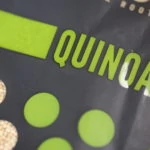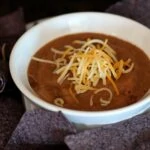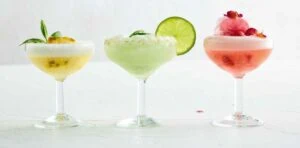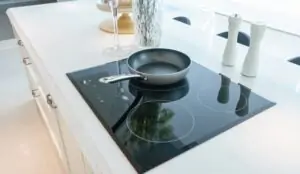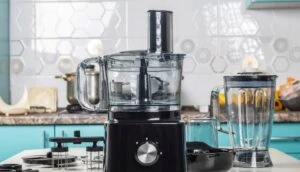Cardamom was one of those spices I didn’t often use, but I did some research, tried some recipes with it, and I’ve grown to love this spice! Let’s take a look at what I’ve learned about cardamom, some cardamom curries and pastries that you might look out for, as well as a few tips when cooking with it.
What is Cardamom?
Cardamom is a sweet and savory spice used in recipes throughout the world. It is primarily found in Asian and Indian cuisine, but can also be found in some Central and South American dishes. It can be purchased in most grocery store spice aisles and online.
What Does Cardamom Look Like?
Cardamom is a small green, fibrous pod about the size of your thumbnail. The fruits grow on elettaria cardamom Maton, a perennial herbaceous bush about 1.5-4.5 meters (4-15 feet) tall. Cardamom fruits and blossoms decorate a twiggy skirt that holds in a group of stalks, flattening into lance-like leaves.
The shape of a cardamom pod is ovoid—somewhat egg-shaped and triangular when cut open laterally. The pod is made of a thin, fibrous shell that surrounds three cells walled-off by arils. The cells contain 15-50, 3-sided brownish seeds, where the cardamom’s aromatic oils are housed.
A cardamom plant’s flowers look a bit like small orchids. They’re white with mauve or yellow stripes depending on the variety, and 40-50 of these lovely blossoms grow on each plant.
The two most common types of cardamom are green and black cardamom, named for the color of their fruits—respectively green through to maturity, and the second, red in immaturity, turning to a dried brownish-red.
How Is Cardamom Made?
The cardamom plant blossoms for its first time in spring when it is three years old, and the first cardamom fruits follow to full maturity between August and October, when they can be harvested.
The cardamom harvesting process is tedious. Fruits are picked or clipped from their twigs, and sorted by maturity and quality. They are cleaned then dried in the sun (in this case, usually green cardamom) or over a sulfur fire (black cardamom), then processed depending on the demands of the market—for example, are more people buying cardamom seeds? Whole cardamom pods? Do most consumers prefer ground cardamom?
In order to preserve their color, flavor, and aroma, and to protect against mold, cardamom pods are stored in double-lined black polytene bags following the drying process, until they show up in the market.
The experts advise purchasing just enough cardamom at a time for a few recipes, especially if it’s ground cardamom, because the palate-tantalizing gift housed in a cardamom pod begins to lose its charm significantly after 12-15 months of harvesting.
The History of Cardamom
My cardamom ventures trace back to the chai tea recipe using ground cardamom that my girlfriend served last November. I found them again when I got a wild hair one summer on my mountain guiding trip and cracked a few between my teeth for the antimicrobial, mouth-freshening benefits I heard tale of in some Verdic 4th century BC texts.
Cardamom is as old as humanity. While I have no right to recommend any medicinal use of cardamom, it is interesting to note that it has been mentioned in incredibly old medicinal texts in India, was for a time a staple trade article for Greeks and Romans, and was used in kings’ decorative landscaping way, way back in the day.
Cardamom Production and Exportation
The world’s greatest cardamom producer is Guatemala, followed by India. Guatemala also doubles as the largest exporter of the herb since India uses the majority of their production for their own culinary delights. The largest importer is Saudi Arabia. A whopping 60% of the world’s cardamom consumption is claimed by western Asia (think India and Saudi Arabia), and the next largest percent (16%) is consumed in Scandinavia. As a global community, we consume between 15,000 and 24,000 tons—let me repeat—15,000 to 24,000 TONS of cardamom. That’s a lot of cardamom.
What are the Varieties of Cardamom?
The most popular cardamom varieties are elettaria cardamomum, a green pod with a profile of mint, pepper, citrus, and eucalyptus well-known as the “cardamom-y” flavor and aroma; and amomum subulatum, or black cardamom, with a dark, smoky flavor profile that takes its time.
How to Use Black Cardamom
Culinarily, the entire pod with seeds can be ground for its fullest flavor, or just the seeds for a smoother, lighter taste. Black cardamom’s wood-like, smoky flavor profile matches best with savory dishes and is not often recommended in sweet foods.
You might find black cardamom under several aliases depending on the region where it is grown. Look out for names like Hill cardamom, Bengal cardamom, Greater cardamom, Nepal cardamom, and Winged cardamom. Under any name, the brownish-red amomum subulatum pod is larger in size than that of the green cardamom, contains approximately double the seeds (40-50 of them), and due to its drying process over a sulfur fire, has a deep smoky flavor that comes with some culinary rules…we’ll get to those below.
Savory dishes that best highlight its flavorful depth include meats, grains, legumes, cauliflower, egg, potatoes, spinach, tomatoes, red and orange vegetables; and other herbs like ginger, basil, fennel, garlic, and lemongrass. Some common recipes that use black cardamom include those for barbecues, Asian sausages and cordials, cardamom cola, and garam masala (Spice It, 2018).
How to Use Green Cardamom
Green cardamom, or elettaria, is the most expensive spice in the world, following saffron and vanilla. It’s smaller form contains approximately 20 seeds where the gorgeous, ginger-like flavor is found that gives it’ sweet/savory flavor that so-well fills in the dishes where black cardamom leaves off—both desserts and main dishes.
The sweet and savory dishes highlighted by green cardamom include stews, meats, vegetables, breads, puddings, ice cream, and garam masala—a common meeting place where both green and black cardamom mingle in brightness and boldness. It has also been traditionally used in recipes such as the Norwegian Christmas bread, Julekake.
Green cardamom pairs well with other spices, including cloves, fennel, anise, and of course ginger.
What is White Cardamom?
White cardamom is green cardamom that has undergone a bleaching process which originally was a natural occurrence due to the sun during its transportation from India to Scandinavia. Scandinavian cuisines have clung to this paled form and flavor, and chemical processing has kept this cardamom in supply. Swedish pastries, the Scandinavian blueberry compote, and Europe’s Speculoos, a Belgian spice cookie, deliver a light and brightening crunch thanks to white cardamom.
Why is Cardamom So Expensive?
Due to the intensive harvesting process, the price of cardamom is the third highest among spices in the world. harvesters generally find 10 ready-to-harvest pods on every plant, and among them, only a few are fit for the market.
You can appreciate the benefits of this ancient spice and support struggling farmers by purchasing cardamom that follows a more ethical supply chain. Companies who strive to live up to these values often tout their ethical practices with phrases like direct-to-consumer, fair-trade, and single-origin.
What Does Cardamom Taste Like?
Cardamom strikes a balance between savory and sweet, and for this it is often used within a spectrum of desserts to savory main dishes, such as ice cream, pastries, fruit salads, breads, curries, casseroles, rice dishes, and meats.
The warming, highly aromatic flavor profile of cardamom is often described by notes like flowery, minty, and even lemony.
Cuisines using this delicious spice are mainly Middle Eastern, Indian, Arabic, and Swedish. Think Turkish coffee, masala chai, basmati rice and garam masala.
The potency of cardamom depends on the pod’s variety, maturity, and how they are dried and stored. The bolder the flavor, the more expensive the spice is.
Where to Buy Cardamom
Cardamom can be purchased in nearly any grocery store that carries spices and baking ingredients. The most common forms sold are whole green pods, ground cardamom seed, and mixes that include ground cardamom like pumpkin pie spice.
Cardamom is presented to the market in several forms: the whole green or black cardamom pod, entire ground pod, ground seed, or husked fruit leaving just the seeds.
How to Cook with Cardamom
As a home cook, whole pods may seem daunting, but the rich aroma and flavor they package in comparison with processed forms like ground (also called powdered cardamom in some recipes) or plain seeds, is well worth their higher price and potential extra work required depending on your recipe.
Whole cardamom pods are used to flavor and add aroma to some soups, sauces, pates, purees, stews, rice dishes, chicken, and seafood.
Cardamom seeds can be bought commercially-processed or you can remove the more flavor-packed seeds from the pods yourself to add a gorgeous crunch to fruit salad, ice cream, rice pudding, custards, or to make Kardemummabullar, a Swedish cardamom pastry.
Ground cardamom or cardamom powder is the finely-milled seed and sometimes the ground whole pod if specified on the package. This form of the spice is used as a traditional sprinkle on top of Turkish or coffee, teas like chai, sweet tea, and milk tea in Arabian cuisines; has for centuries flavored and aromatized European baked goods like cookies, pastries, and breads; and is used in the famous garam masala.
How to Store Cardamom
Ground cardamom, whether bought commercially processed or prepared yourself, shouldn’t be stored long as its flavor has a much shorter shelf-life than do whole cardamom pods.
Make Your Own Ground Cardamom
Begin with cardamom pods. Toast them dry in a skillet over medium heat. Once slightly golden, allow them to cool and remove the seeds from the pods by pinching the pods open with your fingers. The pods can be saved to flavor tea or coffee later. Grind the seeds in a mortar and pestle or automatic spice or coffee grinder, and add to recipes that call for ground cardamom. Following the above toasting directions, whole, unground pods are a delicious addition to slowly-cooked meat or vegetables.
What is a Substitute for Cardamom?
Other spices that have similar flavor profiles and that are often mixed with cardamom to create a more intricate flavor, can also be used with care as substitutes when you’re out of cardamom.
They include:
Nutmeg: nutty, complements porridges, chai, and other teas.
Cinnamon: woody, best supplements cardamom when combined with nutmeg.
Apple Pie Spice: a blend of spices that includes cinnamon, nutmeg, and allspice. This works as a substitute when in a pinch!
Cloves: slightly bitter, great with desserts, meats, and beverages.
Ginger: since cardamom is in the ginger family, this is a relative that can substitute cardamom or vice-versa.
Allspice: warm, smoky undertone similar to black cardamom. It is common in Caribbean cuisine.
*The best black cardamom substitute is a mix of cinnamon, allspice, and nutmeg.
This holiday season, I’m excited to expound on my cardamom use in Colombia by purchasing from local farms and sprucing up my panela tintos with this Cardamom Granita with Cream recipe from CardamomNation. How will you integrate cardamom into your festivities this season?
<iframe width=”560″ height=”315″ src=”https://www.youtube.com/embed/DD82FdbKIS4″ title=”YouTube video player” frameborder=”0″ allow=”accelerometer; autoplay; clipboard-write; encrypted-media; gyroscope; picture-in-picture” allowfullscreen></iframe>


